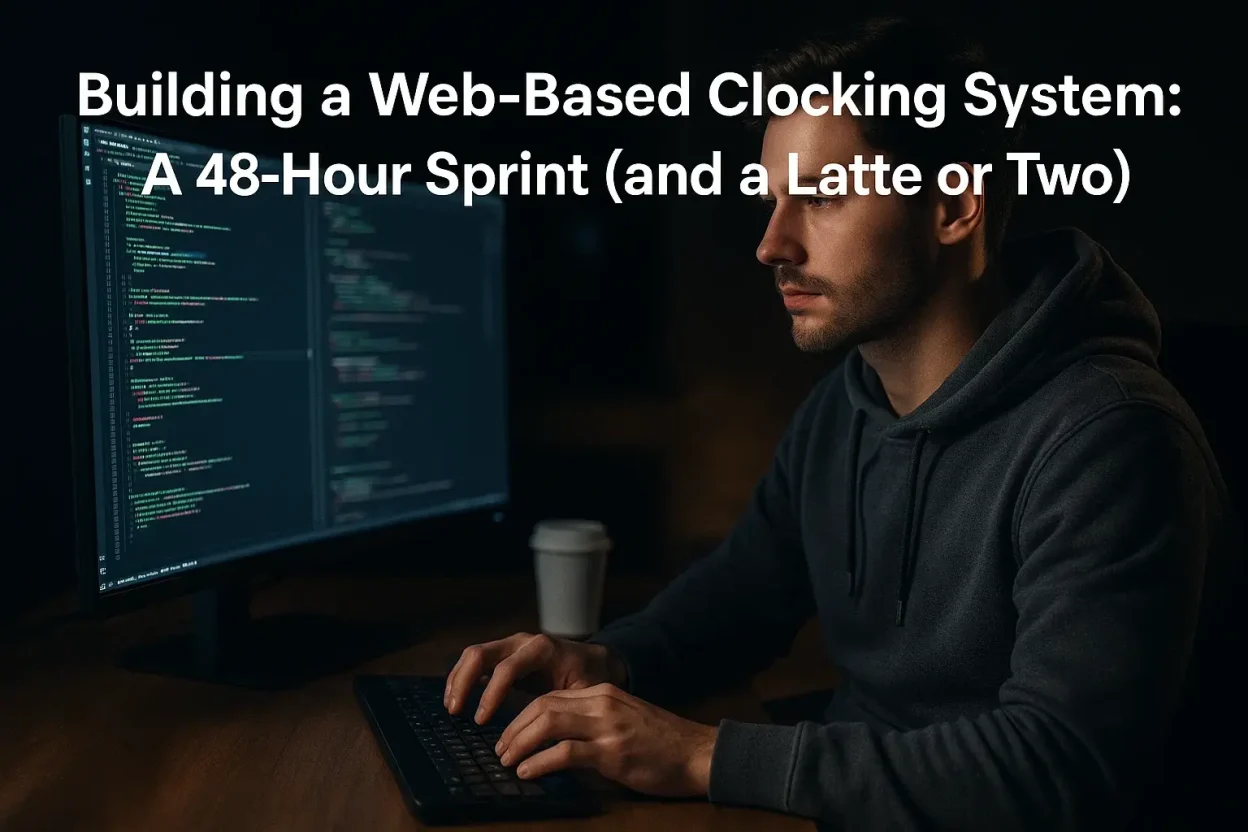Hello there! I’m Zabel Iqbal — your friendly neighborhood business debugger, tech wizard, and, apparently, the fastest web-based clocking system developer on the planet (or at least in Langkawi). Over the course of 48 hours, I single-handedly built a full-fledged employee time-tracking system for a resort in the beautiful Langkawi. Yep, just me, a couple of dozen cups of coffee, and some questionable levels of sleep.
Now, while it might sound like something straight out of a developer’s fever dream, the reality is that this system is actually efficient, user-friendly, and ready to rock and roll. So, grab a coffee (or a cold drink if you’re one of those day shift people), and let me take you through my two-day journey of building this beast!
The Challenge: Developing an All-in-One Time Tracking System in 48 Hours
I was called in by a resort in Langkawi, facing the kind of time-tracking chaos that only someone with years of “night-shift crisis fixer” experience could tackle. Think: employees manually writing their hours down, shift overlaps like a bad soap opera, and attendance sheets that looked like they’d been through a hurricane. The resort needed a solution, fast, and that’s where I came in — the guy who fixes the mess, quietly and without judgment.
The features I had to include were non-negotiable:
- Attendance Management:
No more “guessing” who worked what hours. - Shift Management:
Making sure employees are assigned shifts that actually work (and don’t conflict with the resort’s Wi-Fi schedules). - Department Management:
Organizing the team into departments without starting a mutiny. - Schedule Management:
Because showing up on time is important… and, frankly, a little bit of magic helps.
Key Features Developed (And How I Did It in 48 Hours)
1. Attendance Management: No More Guessing
I started with the foundation: Attendance Management. This feature had to work like a charm because, let’s be real, if the clock-in system isn’t reliable, you’re doomed. So, I built a real-time clock-in and clock-out system that updates instantly and tracks employees like a well-behaved puppy.
- Geofencing:
Employees can’t just check in from anywhere. They need to be at the resort. If they try to clock in from the comfort of their couch at home, no dice. The geofencing works like a digital bouncer, keeping the attendance legit. - Error Handling:
For those “oops, I was 10 minutes late” moments, I added a system to handle late arrivals, early departures, and missed clock-ins. I like to think of it as a “parental control” for time tracking.
2. Shift Management: From Chaos to Order (Without the Dreaded “Shift Tetris”)
The next big hurdle was Shift Management. The resort’s old system was, let’s say, “creative.” Shifts were being assigned like a game of Tetris: blocks everywhere, but no clear picture. So, I developed gap-based relief shift assignments to ensure that employees are moved only when there’s an actual gap — not just because their name was the next one on the list.
Instead of the old “overstaffed shift logic” (which, let’s be honest, rarely works), I focused on finding shifts with spare capacity. The system is now smart enough to detect shifts where someone can be moved without causing a traffic jam. Efficiency, meet intelligence!
3. Department Management: Organizing Chaos (Literally)
Managing a resort with multiple departments can be like herding cats. But department management made everything easier. I created a straightforward system for assigning employees to the correct department, allowing managers to have complete visibility.
- Shift Assignment:
Employees are now assigned to departments based on their roles, and I made sure their shifts reflect their department’s needs. - Real-Time Updates:
Managers can see who’s clocked in from each department at a glance, reducing the “Where is that person?” moments.
4. Schedule Management: The Easy Button for Shift Creation
I’m not saying I invented schedule management (well, I sort of did… but who’s counting?), but I sure as heck made it way easier. I automated the scheduling process so that it adjusts based on employee availability and department needs. If an employee isn’t available, they won’t magically show up on the schedule like an unwelcome guest at a wedding.
The system now handles scheduling with such ease that even my grandmother could figure it out. No more manual inputs or shifting Excel sheets around — it’s all automated and ready to go.
Coming Soon: Future Features That Will Knock Your Socks Off
The clocking system isn’t quite perfect yet — but it’s getting there. I have some coming soon features that will make this system even more magical. And no, I’m not just talking about magic beans.
1. AI Facial Recognition Clock-In
Imagine walking into work and having the system clock you in just by looking at you. No button-pressing. No swiping. Just AI facial recognition doing its thing. This will eliminate buddy punching (no more pretending to be the other guy), and ensure only the right people are clocking in. I call it “AI meets real-world security”. Because we live in the future, folks.
2. Leave Application
It’s time to say goodbye to the paper leave request form. The leave application system will allow employees to request time off with just a few clicks. Bonus points: Managers can approve or reject the requests from their phones while sipping a piña colada (or, you know, during work hours).
3. Staff Performance Metrics
What’s better than knowing your staff is showing up on time? Knowing how they’re performing. This new feature will provide managers with performance data—think work hours, overtime, attendance rates, and general “employee awesomeness” stats (just kidding on that last one… or am I?). It’s all about making sure your team is running like a well-oiled machine, even if it’s running on coffee and determination.
Tech Stack That Made It All Possible
Here’s what I used to bring this clocking system to life (and to sanity):
- Frontend: React.js with Material-UI for sleek, mobile-friendly design.
- Backend: Node.js/Express to handle all the server-side magic (and debugging — because I’m a wizard, not a miracle worker).
- Database: MySQL for keeping track of all employee and shift data.
- Geofencing: To ensure employees are where they should be when they clock in.
- AI: (Coming soon) Facial recognition — because who doesn’t want to be that cool?
The 48-Hour Timeline (And How I Did It Without Losing My Mind)
I was given 48 hours to complete the system. Here’s how I broke it down:
- Hours 1-10: Backend setup, database design, and clock-in/out API creation.
- Hours 11-20: Frontend development and shift assignment logic.
- Hours 21-30: Department management, geofencing, and testing.
- Hours 31-40: Schedule management, bug fixes, and performance optimization.
- Hours 41-48: User testing, final tweaks, and deployment. (Mostly done while consuming a ridiculous amount of caffeine.)
Conclusion: Mission Accomplished (With a Side of Humor)
In just 48 hours, I built a complete web-based clocking system for a resort in Langkawi, complete with attendance tracking, shift management, and department organization. While I may have been running on coffee and my “I fix the mess” mentality, I’m proud of how the system turned out. And with features like AI facial recognition and leave application on the horizon, this is only the beginning.
I’ll leave you with one final thought: I’m Zabel Iqbal — the guy who fixes business messes, makes chaos disappear, and sometimes develops awesome apps in record time. If your business needs a digital janitor (who doesn’t charge by the hour), you know who to call 😉.





[…] Incase you missed where do i began : Building a Web-Based Clocking System: A 48-Hour Sprint (and a Latte or Two) […]
[…] In case you missed my previous post where i began this system development: Building a Web-Based Clocking System: A 48-Hour Sprint (and a Latte or Two) […]
[…] In case you missed my previous post where i began this system development: Building a Web-Based Clocking System: A 48-Hour Sprint (and a Latte or Two) […]
[…] In case you missed how this all began: Building a Web-Based Clocking System: A 48-Hour Sprint (and a Latte or Two) […]
[…] Theme: Off-day logic, notification boundaries, and why silence is sometimes goldenMood: A delicate mix of rage, irony, and passive-aggressive refactoring This is where its begin: Building a Web-Based Clocking System: A 48-Hour Sprint (and a Latte or Two) […]
[…] Status: Mildly traumatized, slightly caffeinated, dangerously sarcasticPrimary Bug Suspect: Math Previous Related Article: Building a Web-Based Clocking System: A 48-Hour Sprint (and a Latte or Two) […]
[…] Scheduling where I tackled the chaos of employee shift management, or go all the way back to Building a Web-Based Clocking System: A 48-Hour Sprint and a Latte or Two for my mad dash to create a time-tracking system in just 48 […]
[…] up on how this whole system began by reading 👉 Building a Web-Based Clocking System: A 48-Hour Sprint and a Latte or Two It’s the origin story of this scheduling beast — built from scratch in two days with nothing […]